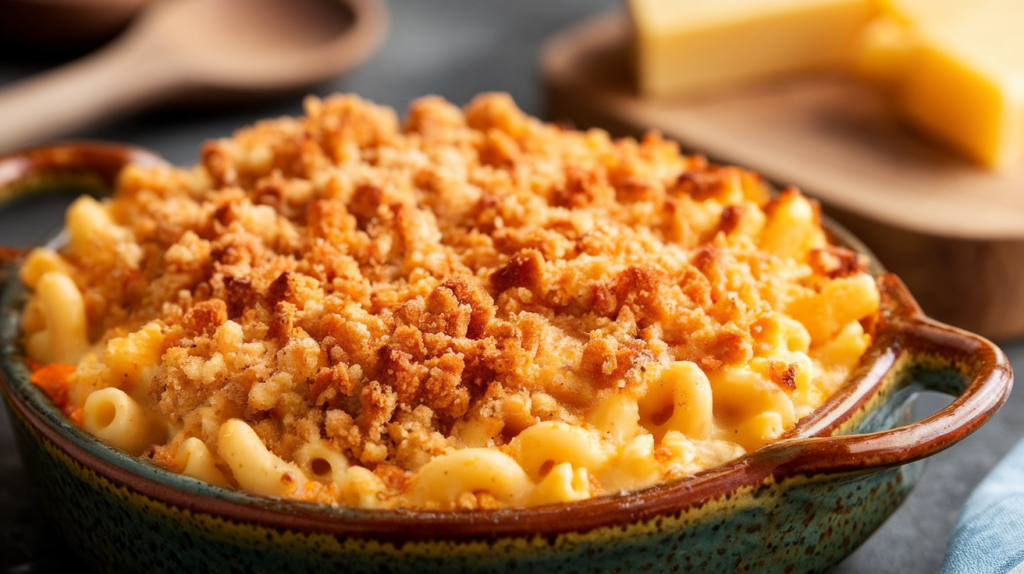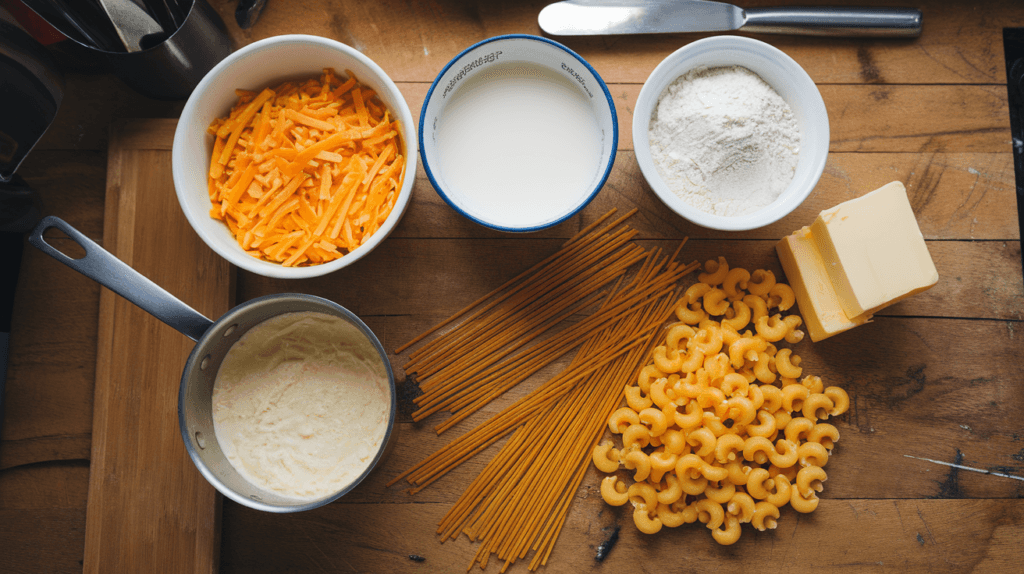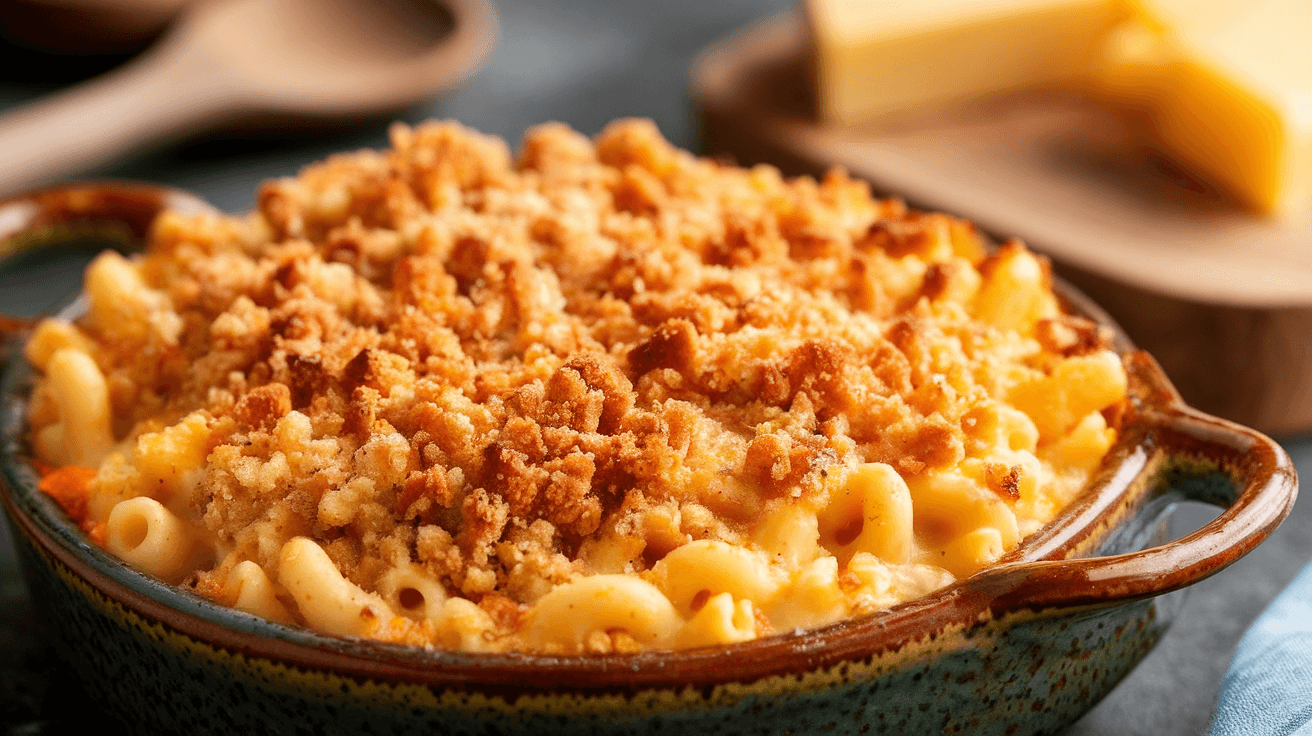Introduction
Baked mac and cheese is a beloved comfort food for many, offering a combination of creamy, cheesy goodness and satisfying textures. However, it’s all too easy to end up with a dish that’s dry, grainy, or lacking the velvety smoothness we crave. If you’ve been wondering, “Why isn’t my baked mac and cheese creamy?” you’re not alone. This article will explore the common pitfalls, key ingredients, and expert tips to ensure your next baked mac and cheese is irresistibly creamy.
From selecting the right cheese to mastering your cooking technique, we’ll guide you through the science and artistry of this classic dish. Let’s dive in and uncover the secrets to the perfect creamy baked mac and cheese!

Why Your Baked Mac and Cheese Isn’t Creamy: Common Mistakes
How Cheese Selection Impacts Creamy Baked Mac and Cheese
The type of cheese you use plays a crucial role in determining the creaminess of your baked mac and cheese. Some cheeses, like cheddar, melt beautifully, while others, like parmesan, can become grainy or greasy when heated. Avoid using hard or aged cheeses as the primary ingredient; instead, opt for varieties known for their melting properties, such as mozzarella, gouda, or Monterey Jack. Mixing cheeses can also help create a balance of flavor and texture.
Pre-Shredded Cheese: Why It Ruins Creamy Mac and Cheese
Pre-shredded cheese might save time, but it often contains anti-caking agents like cellulose, which prevent the cheese from melting smoothly. These additives can result in a clumpy or grainy sauce. Always shred cheese fresh from the block for the best results. Freshly grated cheese ensures even melting and contributes to the creaminess of the dish.
Best Pasta for Creamy Baked Mac and Cheese
The type of pasta you choose can make or break your mac and cheese. Traditional elbow macaroni works well because its small, hollow shape holds sauce effectively. Other great options include cavatappi, shells, or penne. Avoid using thin or overly large pasta shapes, as they may not hold the sauce as effectively, leading to a dry final product. Always cook the pasta al dente to avoid a mushy texture during baking.
Cooking Techniques That Make Baked Mac and Cheese Creamy
How Overbaking Makes Baked Mac and Cheese Dry
One of the most common culprits of dry baked mac and cheese is overbaking. While it’s tempting to leave the dish in the oven a little longer to achieve a golden, crispy topping, excessive baking causes the cheese sauce to dry out. This not only affects the texture but can also make the dish taste burnt. Always follow recommended baking times and check for doneness by observing the sauce bubbling lightly around the edges.
Skimping on the Sauce
A creamy baked mac and cheese requires plenty of sauce to coat the pasta thoroughly. Many recipes underestimate the amount of sauce needed, leading to a dry and underwhelming result. A good rule of thumb is to prepare extra sauce to ensure every piece of pasta is well-coated. Remember, it’s better to have too much sauce than too little when aiming for a creamy texture.
Improper Sauce-to-Pasta Ratio
Achieving the right balance between pasta and sauce is key to creaminess. Too much pasta absorbs the sauce and leaves the dish dry, while too much sauce can make it overly soupy. Aim for a ratio where the sauce generously coats the pasta without overwhelming it. A 2:1 ratio of sauce to pasta (by volume) typically works well for baked mac and cheese.
Essential Ingredients for Creamy Baked Mac and Cheese

High-Moisture Cheeses
The type of cheese you use directly impacts the creaminess of your mac and cheese. High-moisture cheeses like cheddar, fontina, gouda, and brie melt smoothly and create a luscious sauce. Combining different cheeses can enhance both flavor and texture, as some cheeses add creaminess while others contribute a sharper taste. Avoid low-moisture cheeses or those with a crumbly texture, as they may result in a grainy sauce.
Quality Milk and Cream
The liquid base of your cheese sauce is just as important as the cheese itself. Whole milk, half-and-half, or heavy cream are ideal for creating a rich and creamy sauce. Skim or low-fat milk can result in a thinner, less satisfying texture. For added depth, you can combine cream with evaporated milk, which has a thicker consistency and enhances the creaminess of the dish.
Thickening Agents and Their Role
A roux (a mixture of flour and fat) is the foundation of a velvety cheese sauce. The roux thickens the sauce and provides a stable base for the cheese to melt evenly. Other thickening agents, like cornstarch or egg yolks, can be used as alternatives, but they may alter the texture. Mastering the roux technique ensures your sauce is smooth, creamy, and free of lumps.
Step-by-Step Guide to Fix Common Issues
Making a Proper Roux
The roux is the cornerstone of a creamy cheese sauce. To make a proper roux, start by melting butter in a saucepan over medium heat. Add an equal amount of all-purpose flour and whisk continuously for 1-2 minutes until the mixture is golden and bubbly. Gradually pour in warm milk or cream while whisking to avoid lumps. Cook the mixture until it thickens, creating a smooth and creamy base for the cheese sauce.
Balancing Ingredients
Achieving the perfect balance of ingredients is essential to creamy baked mac and cheese. Use a combination of cheeses for depth of flavor and a mix of whole milk and cream for richness. When incorporating the cheese into the sauce, add it gradually and on low heat to prevent curdling. If the sauce seems too thick, a splash of milk can help loosen it, while a sprinkle of cheese can thicken it if needed.
Perfecting the Bake Time
Baking your mac and cheese for the right amount of time is critical to maintaining its creamy texture. Preheat your oven to the recommended temperature and bake just until the top is golden and the sauce is bubbling around the edges. Overbaking will dry out the sauce, while underbaking can leave the cheese undercooked. Typically, 20-30 minutes at 350°F (175°C) is ideal for most recipes.
Tips for Preventing Dry Mac and Cheese in the Future
Storing and Reheating Tips
Leftover baked mac and cheese can often dry out, but proper storage and reheating techniques can preserve its creamy texture. Store the dish in an airtight container in the refrigerator for up to 3-4 days. When reheating, add a splash of milk or cream to revive the sauce’s consistency. Heat gently in the oven at 300°F (150°C) or in a skillet on low heat, stirring occasionally to prevent drying out.
Adding Toppings Without Sacrificing Creaminess
Crispy toppings like breadcrumbs or shredded cheese can enhance the dish without making it dry. To achieve this, add the toppings only in the last 5-10 minutes of baking. This ensures the base remains creamy while the top becomes golden and crunchy. If you prefer a softer texture, cover the dish with foil while baking and remove it near the end for a light crisp.
Experimenting with Recipes
Every mac and cheese recipe can be tweaked to suit your preferences. If you find your dish consistently turns out dry, try adding more liquid to the cheese sauce or experimenting with different cheese combinations. For a foolproof recipe, consider incorporating cream cheese or mascarpone, as these ingredients add extra creaminess. Don’t be afraid to customize spices and flavors for a dish that’s uniquely yours.
Creative Variations for Creamy Baked Mac and Cheese

Adding Protein for a Complete Meal
Baked mac and cheese can be transformed into a hearty main course by adding proteins like shredded chicken, cooked bacon, or ground beef. These additions not only make the dish more filling but also add layers of flavor. For a seafood twist, consider incorporating cooked lobster, crab, or shrimp for a luxurious variation.
Incorporating Vegetables for Added Nutrition
Boost the nutritional value of your mac and cheese by adding vegetables. Broccoli, spinach, roasted butternut squash, or sautéed mushrooms pair wonderfully with the creamy cheese sauce. These ingredients can be mixed into the pasta before baking or layered on top for a vibrant presentation.
Experimenting with International Flavors
Give your baked mac and cheese a global twist by incorporating spices and ingredients from different cuisines. For example:
- Mexican Style: Add jalapeños, salsa, and a blend of cheddar and queso fresco, then top with crushed tortilla chips.
- Italian Style: Use a béchamel sauce with parmesan and mozzarella, then layer with marinara sauce and Italian herbs.
- Indian Style: Mix in spices like turmeric, cumin, and garam masala, then garnish with fresh cilantro.
Using Alternative Cheeses and Dairy-Free Options
If you’re catering to dietary preferences, consider using plant-based cheeses or dairy-free alternatives. Coconut milk, almond milk, or cashew cream can replace traditional dairy for a creamy texture. Vegan cheese blends made from nutritional yeast, tofu, or cashews are also great substitutes that don’t compromise on flavor.
Gourmet Toppings for an Upscale Touch
Elevate your mac and cheese with sophisticated toppings. Try a sprinkle of truffle oil, a handful of crispy prosciutto, or a layer of toasted panko breadcrumbs mixed with fresh herbs and parmesan. These toppings add a gourmet touch and enhance the dish’s visual appeal and taste.
Science Behind Creamy Mac and Cheese
How Cheese Melts and Stays Creamy
The creaminess of mac and cheese depends on how the cheese melts and emulsifies into the sauce. Cheese is made up of fat, protein, and water. When heated, the fat melts, and the proteins unwind, creating a smooth and creamy texture. However, overheating can cause the proteins to clump together, resulting in a grainy or oily texture. That’s why using low heat and stirring gently is key to maintaining the sauce’s consistency.
The Role of Starches in Stabilizing Sauce
Starches, such as those from flour or pasta, play a crucial role in stabilizing the cheese sauce. When a roux is made, the starch in the flour absorbs liquid and swells, creating a thick, stable base. This prevents the cheese from separating and ensures a smooth sauce. Pasta also releases starch during cooking, which helps the sauce adhere better to the noodles, adding to the overall creaminess.
Why Fat Content Matters
Fat contributes to the luscious texture of mac and cheese. Whole milk, cream, and high-fat cheeses create a richer sauce compared to low-fat alternatives. Fat also acts as a flavor carrier, enhancing the cheesy taste of the dish. Balancing fat with starch and liquid ensures the sauce remains creamy without becoming overly greasy.
The Importance of Emulsifiers
Emulsifiers, such as those found in processed cheese or added in recipes like sodium citrate, help bind water and fat together in the sauce. These agents prevent the sauce from breaking and maintain a smooth, homogenous texture. While traditional recipes rely on natural emulsifiers in cheese, experimenting with small amounts of processed cheese can improve stability without compromising flavor.
Temperature Control for Creamy Results
Temperature plays a critical role in the science of creaminess. Gradually heating the sauce ensures the cheese melts evenly without separating. Using room-temperature ingredients also helps maintain a consistent texture. Avoiding high heat during baking prevents the sauce from drying out or curdling, ensuring the dish remains perfectly creamy.
FAQ
Why does my cheese sauce turn grainy?
Grainy cheese sauce is often caused by overheating the cheese, which causes it to separate. Always melt cheese on low heat and add it gradually to a warm sauce base for a smooth texture.
How can I prevent my mac and cheese from drying out in the oven?
To prevent dryness, use plenty of sauce, cover the dish with foil while baking, and bake at a moderate temperature. Adding a splash of milk before baking can also help keep the dish moist.
What is the best cheese combination for creamy mac and cheese?
A blend of sharp cheddar, Monterey Jack, and Gruyere works well for a creamy and flavorful mac and cheese. Experiment with other high-moisture cheeses to suit your taste.
Can I make baked mac and cheese ahead of time?
Yes, you can assemble the dish ahead of time and refrigerate it before baking. Add extra sauce to compensate for any absorption by the pasta, and bake it fresh to maintain creaminess.
What is the ideal pasta-to-sauce ratio?
A 2:1 sauce-to-pasta ratio (by volume) ensures the pasta is well-coated without being too dry or too soupy. Adjust as needed based on your preferences.
How can I fix dry mac and cheese after baking?
If your dish turns out dry, mix in a small amount of warm milk or cream and stir gently to revive the sauce. Cover the dish with foil and bake briefly to blend the flavors.
Conclusion
Achieving the perfect creamy baked mac and cheese requires attention to detail, from choosing the right ingredients to mastering the cooking technique. By avoiding common mistakes and following the tips shared in this article, you can elevate your dish to new levels of creamy, cheesy perfection. Whether you’re preparing it for a family dinner or a special occasion, these insights will help you create a dish that’s as delicious as it is satisfying. Happy cooking!

